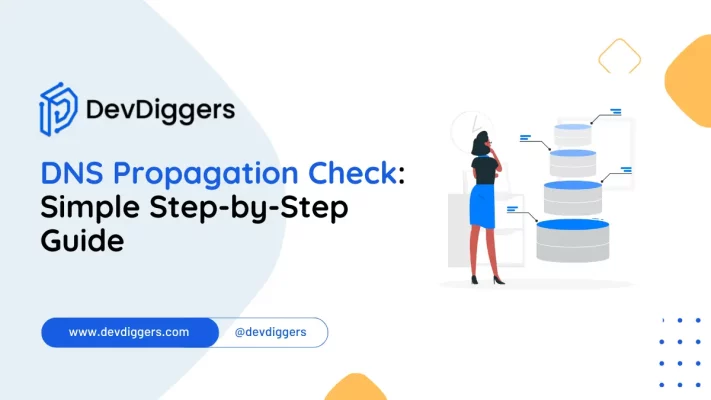DNS Propagation Check: Simple Step-by-Step Guide

The Domain Name System, also known as DNS, is the foundation of the global web. It converts domain names that humans understand into Internet Protocol (IP) addresses that computers understand. A DNS propagation check ensures a seamless transformation throughout these modifications.
Webmasters regularly discover themselves in circumstances in which they must implement modifications to their domain setup due to the constantly changing nature of the World Wide Web.
These modifications might be as simple as changing their domain name or as complex as switching to a different web server company or Internet Protocol (IP) address for their website.
Although these changes are necessary, they can sometimes be difficult, the most common of which is DNS maintenance.
We’ll discuss DNS propagation, its importance, and how to execute DNS propagation checks to ensure your modifications have spread throughout the global web.
Table of Contents
Knowing How DNS Propagation Works
DNS propagation is the procedure of adding the latest data regarding your domain to the international DNS servers.
Any modifications you apply to your domain configuration, like altering your domain name, altering your DNS files, or switching hosting companies, must take effect immediately throughout the internet.
Global DNS servers must synchronize and upgrade their databases to reflect your modifications during this procedure. Until this upgrade occurs, you might observe a few customers being redirected to the previous server and others being transferred to the latest one.
This transformation phase may take a few hours to as long as 48 hours. However, in exceptional circumstances, it could take more.
The Importance of DNS Propagation

DNS propagation is an essential part of website management. Knowing the value of DNS propagation checks before and after implementing modifications to your domain may help you understand the necessity.
The following are a few main factors for why DNS propagation is important:
1. Customer Interaction
You desire your clients to have flawless access to any modifications to your domain. Some visitors may continue to view the outdated edition of your website, whereas others view the latest one as it spreads.
It is important to guarantee quick propagation since this discrepancy might result in bad customer interaction.
2. Electronic Mail Providers
If your website is linked to email facilities (for example, by modifying the mail server configuration), delayed DNS propagation might cause email transmission problems, leading to the loss of crucial notifications.
3. Search engine optimization (SEO)
DNS data is necessary for search engines such as Google to rank your site. Your search engine ratings may suffer if your DNS data propagates inconsistently.
4. Preventing Data
The security of your data depends on seamless DNS propagation, which is very important if you’re switching domain names or moving to a new server company. It aids in avoiding data loss when making the switch.
The Way a DNS Propagation Checking Works
It is rather easy to conduct a DNS propagation check, which can inform you how your DNS modifications are progressing. The process for doing the DNS propagation checks is as follows:
1. Knowing DNS Updates
When starting a DNS propagate test, it is essential to comprehend the modifications you have implemented in your site’s setup.
Whenever you upgrade the DNS data, transfer to a newer server provider, or change the web address, fully understanding the changes can help you properly perceive the anticipated DNS propagation outcomes.
2. Delete the Cache for Regional DNS
Clear your personal DNS cache to verify that you do not have cached DNS data. This procedure is essential to receiving highly precise DNS propagation checking outcomes.
Start a command prompt or terminal window and type the relevant code for your operating system to delete your machine’s cache. For instance, users can execute the Windows function ipconfig /flushdns.
3. Utilize Web DNS Propagation Software
Many internet applications allow you to verify DNS propagation from various global sites. These applications check when the modifications have taken effect by sending queries to DNS servers across different regions.
4. Examine the Outcomes
Following the DNS propagation supervision, a collection of DNS servers and their answers will appear.
These answers will help you determine if your DNS modifications have taken effect. Check for continuity between sites for a seamless alteration.
5. Verify the TTL Number
A critical component of DNS data is Time to Live (TTL). It indicates the duration DNS servers must maintain DNS data in caches.
If your TTL value is configured extremely high, propagation may be delayed. Reducing the TTL value before applying modifications can speed it up.
6. Hold off Till Complete Propagation
Maintaining patience for complete DNS propagation is important, even if you can observe updates in a few places. In extreme circumstances, it may take 48 hours or more.
Monitor the DNS entries throughout this period to ensure the modifications are applied consistently everywhere.
Some Advice for Easy DNS Propagation

Implement these recommendations to guarantee a seamless DNS propagation:
- Make Some Preparations: It is best to prepare earlier for DNS modifications. Before starting the modification, verify that you’ve got everything needed, including new Internet Protocol (IP) addresses and DNS entries.
- Reduced TTL Values: As explained, smaller TTL values will help DNS transmission. Remember to decrease the TTL values applied to your DNS entries a few days earlier when implementing any major modifications.
- Choose a Trustworthy DNS Supplier: Select a trustworthy DNS supplier or Administrator to administer your domain configuration. A competent supplier can contribute to a more seamless changeover.
- Track Your Progress: Use internet resources to monitor the progress of your DNS propagation. This will assist you in spotting any problems promptly and, if necessary, taking steps to fix them.
- Have Patience: DNS propagation might be slow. Sometimes, it takes a day or two to solve, but sometimes, there are delays. Please be calm and give the procedure time to finish.
To Summarize
A DNS propagation check has become necessary to manage modifications to your site’s domain configurations.
This ensures that the DNS entries are constantly altered throughout the global web, guaranteeing flawless customer interaction and averting any problems involving mail resources and search engine optimization.
Implementing the instructions in this guide and exercising patience throughout the propagation procedure will help you handle domain upgrades confidently and reduce interruptions in your digital existence.
Preparation and observation are essential to ensure that DNS propagation proceeds well. Selecting a trustworthy DNS supplier can also expedite the entire procedure.




